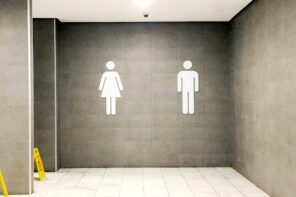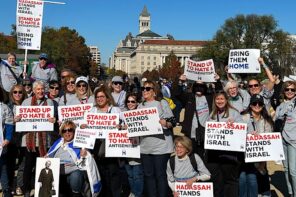What inspired you to write Through the Door of Life?
Early in my gender transition process, my therapist urged me to write an autobiography. “How can I do that?” I responded. “To write an autobiography, you need a self and a life, and I don’t have either.” I wasn’t being flip or figurative. I had lived 40+ years hiding behind a male persona; my self, my true self, the female self I felt was actually me, had literally never seen the light of day. None of my life experiences—the stuff of autobiography and memoir—reflected that self.
When I was a little further along in transition, occasionally spending a few hours a week dressed as myself, a close friend urged me to start writing down what I was telling her about my gender identity. But she hated the essay I wrote—a detached presentation of what trans people call “Trans 101,” basic education about trans issues. “You’re writing like a man,” she said, referring to the impersonality of the essay, its lack of autobiographical specifics.
I thought of impersonality as writing like an academic, not writing like a man, but I got her point, and was simultaneously inspired and terrified when she told me, “You have to write like a woman.” How could I do that? I didn’t even know what that meant—I still don’t. But I knew she was challenging me to write as my true self, to stop hiding behind the habits of abstraction and detachment that I had perfected as part of my male academic persona—to be me, the real me, on the page if not yet in the world beyond it. That’s what scared me. What if I couldn’t write as my true self? What if there was no true self to do that writing?
I tell writing students that our fears are like spotlights shining on closed doors. Opening those doors may or may not lead to good writing, but they always lead to important discoveries about ourselves. I had given that advice too many times not to take it, so I trashed the first essay and started writing about gender transition in the way that scared me the most: personally, autobiographically, as honestly and vulnerably as I could. My friend approved of the result, but that wasn’t why I kept writing.
The experience of writing as my true self for a few pages made me hungry for more. I realized that writing about gender transition could be part of my transition, a way of exploring who I had been and who I was becoming, of living and learning to live.
What’s the most important take-home message for readers?
I didn’t write the book to promote a specific message; I wrote it to try to create language that would enable non-trans readers to see trans experience, at least my little piece of it, through the eyes of someone going through gender transition.
Of course, by rooting the book in my personal experience, I limit its range. I’m only one trans person, male-to-female transsexuals constitute a small fraction of the transgender world, I am very much a product of a white, middle-class, mid-twentieth-century upbringing, I’m a religious (though not Orthodox) Jew, I’m an academic, and so on. But my hope was that by presenting my experience as specifically and intimately as possible, others would recognize aspects of that experience that relate to their own experience of struggling to become and be true to themselves.
I also hope to broaden the perspective in which gender transition is viewed, to show that even when my life was most focused on gender transition, my gender identity was still only one part of a life that centered on relationships with my family, with God, with friends and students and colleagues.
At the same time, I wanted to register the effects of my transition on those relationships: the anguish of my wife and children, the breakdown of my marriage, the strain on my Orthodox Jewish university, the extraordinary generosity and patience of the friends—surrogate mothers— who saw me through the death of my male persona and messy birth and baby steps of my true self.
If there is one overriding “message,” it is that, as Moses says shortly before dying in sight of the Promised Land, human beings are obligated to choose life, real life, life as our wholest, truest selves. We may not want to choose life—often it feels safer and easier to live something short of real life—but that is what God is summoning us, pleading with us, waiting for us, to do.
Is there anything you had to leave out?
Even the longest, least edited memoir leaves out most of life — and that’s a good thing. Descriptions of me brushing my teeth and so on wouldn’t be worth readers’ time. Because so much of the book concerns things that are hard to think about, I felt obligated to make sure that what I included would be relevant not just to me (even now that I have a self and a life, I don’t think they are particularly interesting or important), but to others, to our common struggles with gender, identity, and the crises we face when what we know about ourselves doesn’t fit what others think they know about us.
I also was conscious that no matter how personally I wrote, I wasn’t only telling my story — I was sharing parts of my now ex-wife’s and children’s stories. Memoirs and autobiographies always compromise others’ privacy, and present others in ways they wouldn’t choose to present themselves. Memoir writers get the first and last word, and all the words in between; that is inherently unfair to those who appear in our stories. When, as in my memoir, those stories include acrimonious divorce and family break-up, the ethical stakes are even higher.
I didn’t solve those ethical problems in my memoir — I don’t think they can be solved — but I tried to be as conscious of them as I could, and I asked those who read my drafts to flag anything they thought was disrespectful to or judgmental of my ex or a violation of her or my children’s privacy. I tried to apply the same standards to what I said about them as I applied to what I said about myself: to only say what was necessary to promote understanding about the difficult issues I was discussing.
I felt morally obligated to talk about the ways in which my ex-wife and children suffered as a result of my transition, because such suffering is widespread in families that go through gender transition. I felt obligated not to talk about things that would only apply to my ex and my children, and I asked my daughters’ therapist to review the chapters in which I talked about my children and tell me what she thought should be omitted.
Strangely enough, I also felt it was important to leave out anything connected with my life as a writer and scholar, even though no one’s privacy was at stake. I felt that those activities reflected such particular combinations of personal proclivity, class privilege and education that they weren’t generally relevant. That’s why I never thought of this book as a memoir; my goal wasn’t represent myself, but to offer myself and my experience as ways of thinking about broader issues of being human.
What are some of the biggest misconceptions about your topic?
Even today, when books, articles and TV shows about transgender issues seem to be cropping up all the time, there is little general understanding of transgender identity or the struggles trans people face. For most people, the fit between the physical maleness or femaleness of their bodies and their sense of themselves as male or female makes it hard to think of sex and gender as separate, and not necessarily coordinated, aspects of being human. But for transgender people, our physical maleness or femaleness doesn’t translate simply or directly into our gender identities — which means that the assumptions and conventions that go along with binary conceptions of sex and gender don’t work for us.
Non-trans people also tend to be confused by the relationship between the recently-minted umbrella term “transgender,” which includes all people whose gender identities are more complex than “male” or “female,” and specific transgender identities such as “transsexual.” I’m a transsexual — someone born with a male body and female gender identity — but though transsexuals are included in the umbrella category “transgender,” transsexual gender identity is quite different from other transgender identities, such as those who are gender fluid or genderqueer.
This brings me to another misconception, the idea that there is a “transgender community.” Though transgender people may march in the same parades and fight for the same basic rights to express our gender identities without social or legal persecution, the concerns of transsexuals, for example, which include the need for health care related to gender transition, have little to do with those of male cross-dressers, who need safe places to express and share part-time female identities, and spend most of their lives living quite happily as men.
By the same token, although transgender people tend to be lumped in with gay, lesbian and bisexual people, as in the common acronym “LGBT,” transgender identity isn’t connected to sexual orientation or desire. Some gay people express their genders in ways that are outside binary social norms, as when gay men are attacked for seeming feminine, or gay women are attacked for seeming masculine; some transgender people have same-sex partners; and gay and trans people are subject to violence by many of the same people, who tend not to make fine distinctions between the objects of their hatred. But gender identity and sexual orientation are separate aspects of human identity. Being gay doesn’t teach you what it’s like to be transgender, and being trans doesn’t teach you what it’s like to be gay.
But probably the most important popular confusion regarding transgender identity is how non-trans people should treat us. “Male” and “female” are such a fundamental categories of human identity and social relationship that when we meet people who don’t fit those categories, we not be sure what social norms, if any, apply. For example, many non-trans people aren’t sure what pronouns to usd when referring to transgender people. Companies, schools and legislatures debate about what public restrooms we should be allowed to use — and whether it should be legal to fire or not hire transgender employees whose gender presentation may make clients, customers or co-workers uncomfortable.
Traditional Jews and Christians — the religious traditions with which I’m most familiar — wonder whether trans people should be welcomed in their religious communities, or whether trans identity constitutes a sin against or rejection of God.
But no matter how complicated our gender identities and expressions or the issues they raise may seem, the rules for relating to trans and non-trans people: be respectful, be kind, politely ask about things you don’t understand and give us the space to decline to answer if we prefer not to, and, above all, stay focused on the humanity we share with you rather than the aspects of our gender that make us seem strange.
Did you have a specific audience in mind when writing?
As you can see, I saw primarily thought of myself as writing to non-trans people, people to whom gender transition might seem strange, frivolous (a “life-style choice” rather than existential necessity), delusional, or — to use the most common anti-trans stereotype — irredeemably selfish. I wanted to offer non-trans people as intimate a glimpse as I could of my mind-body relationship, to help them understand how it feels to live it, and, ultimately, I hoped, to recognize my struggles to become myself as akin to theirs — as an intense, spectacular example of what it means to become a person.
Are you hoping to just inform readers? Entertain them? Piss them off?
As I said in my last answer, I am hoping that even readers who have always been completely comfortable with their sex and gender will identify with the struggles that accompany trans identity and gender transition: the urgency, ecstasy and terror of becoming our true selves; the tragic conflicts involved when being true to ourselves means changing aspects of ourselves that are central to our relationships with others; the discovery that we can loved and welcomed — not just hated and rejected — for becoming who we truly are.
What alternative title would you give the book?
Before publication, my girlfriend pointed out that the ideal title was one I had already used for my fifth collection of poetry: Coming to Life.
How do you feel about the cover?
As an academic, I was appalled at first when my press insisted that my face be on the cover of the book. But I love my photographer, Lisa Ross — I couldn’t help but smile when I was looking at her — and had a great time doing the photo shoot on the roof of my girlfriend’s building on Manhattan’s upper west side. More importantly, I now understand why my press thought it was important to have my face on the cover. A number of reviewers and readers have said that it would have been tough to read through the pain and trauma the book details if they didn’t know the result was the smiling face on the cover.
Is there a book out there you wish you had written? Which one? Why?
There are many books I admire, and many writers (mostly poets, since that’s my primary vocation as a writer) whose abilities inspire my awe and envy, but I’ve never wished I’d written someone else’s book. For me, writing is a way of being alive — when I lived as a man, it was my only way to feel alive. I am grateful to have written the books I’ve written, and can’t imagine writing anyone else’s.
What’s your next book?
I’m working on a new collection of poetry, tentatively (very tentatively — I’m a terrible titler) entitled Otherness. Two more poetry collections, Impersonation and Fireworks in the Graveyard, are making the rounds. I am compiling a collection of essays, and am gestating proposals for two book projects that are close to my heart, one on how the Torah looks when read from a transgender perspective, and the other on the brand-new field of trans poetics, recently and spectacularly brought to American literary life by TC Tolbert’s and Trace Peterson’s new anthology Troubling the Line: Trans and Genderqueer Poetry and Poetics.




